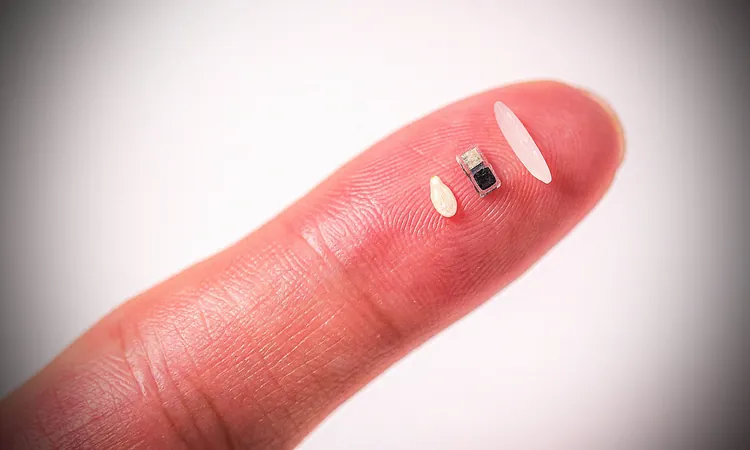
Revolutionary Tiny Pacemaker Set to Transform Heart Health
2025-04-09
Author: Yan
A Marvel of Modern Medicine
In an astonishing leap forward for medical technology, engineers have unveiled a groundbreaking light-activated pacemaker that is so minuscule it can be injected through a syringe. This incredible device is designed to dissolve safely in the body once it is no longer needed.
A Game Changer for Newborns
Specifically crafted for newborns, this innovative pacemaker has the potential to redefine temporary heart care, especially following surgeries for congenital heart defects.
Controlling Hearts with Light
Measuring smaller than a grain of rice, the pacemaker is triggered by light pulses from a soft, wearable device affixed to the patient’s chest. The external controller identifies abnormal heart rhythms and transmits light to activate the pacemaker, restoring a normal heartbeat. Research has confirmed its effectiveness in both animals and human donor hearts.
Professor John A. Rogers of Northwestern University, who spearheaded the development, stated, “We have created what is, to our knowledge, the world’s smallest pacemaker. Temporary pacemakers are critical in pediatric heart surgeries, and minimizing size is paramount.”
Designed for the Most Vulnerable
While this light-activated device can serve patients of all sizes, its diminutive design was intentionally developed with infants in mind. Co-leader of the study, Igor Efimov, emphasized that 1% of children are born with congenital heart defects, requiring just a week of pacing after surgery—an essential period when the heart begins to heal on its own.
Traditional pacemakers necessitate surgery and leave wires protruding from the chest, which pose risks of bleeding, tissue damage, or worse. Efimov pointed out, “These wires can become enveloped in scar tissue, a complication that can have dire consequences.”
No More Wires or Scars
This innovative injectable pacemaker mitigates such risks. Composed entirely of biocompatible and bioresorbable materials, it dissolves harmlessly in the body after fulfilling its purpose.
Pushing Boundaries of Size
This new design builds upon previous efforts that produced a quarter-sized dissolvable pacemaker. Surgeons called for a smaller model, leading to innovations such as replacing traditional communication systems with a light-based mechanism.
Professor Rogers explained, “We transformed the wireless control from a radio frequency to a light-based approach, which significantly reduced the device's size.”
Powered by the Body's Own Fluids
Engineers also revamped the power source for this petite pacemaker. Instead of requiring conventional batteries, it harnesses a simple galvanic cell, using the body’s own fluids as an electrolyte to generate the necessary electrical current.
Reducing Risk and Trauma
Utilizing infrared light that penetrates deeply, the wearable controller detects when a heart rate drops too low and activates the pacemaker. Efimov notes, “Our bodies are excellent conductors of light.” Despite its tiny dimensions—measuring just 1.8 mm wide, 3.5 mm long, and 1 mm thick—the pacemaker delivers stimulation similar to conventional devices.
Ushering in a New Era of Heart Care
With their miniaturized and wireless capabilities, these light-activated pacemakers could allow doctors to deploy several units across the heart for advanced pacing systems, each controllable through different light wavelengths.
Professor Rogers highlighted their adaptability, mentioning how these devices could be integrated with various implantable systems, addressing complications during recovery.
Future Possibilities Beyond Cardiology
This breakthrough holds tremendous promise not just for pediatric heart care but could also herald a new era in bioelectronic medicine. These tiny, dissolvable devices may eventually adapt to support nerve and bone regeneration, pain management, and wound healing, revolutionizing patient care from infants to adults.
The groundwork for this medical marvel was laid by engineers at Northwestern University, who have successfully minimized both risks and size, setting a new standard in heart care.

 Brasil (PT)
Brasil (PT)
 Canada (EN)
Canada (EN)
 Chile (ES)
Chile (ES)
 Česko (CS)
Česko (CS)
 대한민국 (KO)
대한민국 (KO)
 España (ES)
España (ES)
 France (FR)
France (FR)
 Hong Kong (EN)
Hong Kong (EN)
 Italia (IT)
Italia (IT)
 日本 (JA)
日本 (JA)
 Magyarország (HU)
Magyarország (HU)
 Norge (NO)
Norge (NO)
 Polska (PL)
Polska (PL)
 Schweiz (DE)
Schweiz (DE)
 Singapore (EN)
Singapore (EN)
 Sverige (SV)
Sverige (SV)
 Suomi (FI)
Suomi (FI)
 Türkiye (TR)
Türkiye (TR)
 الإمارات العربية المتحدة (AR)
الإمارات العربية المتحدة (AR)